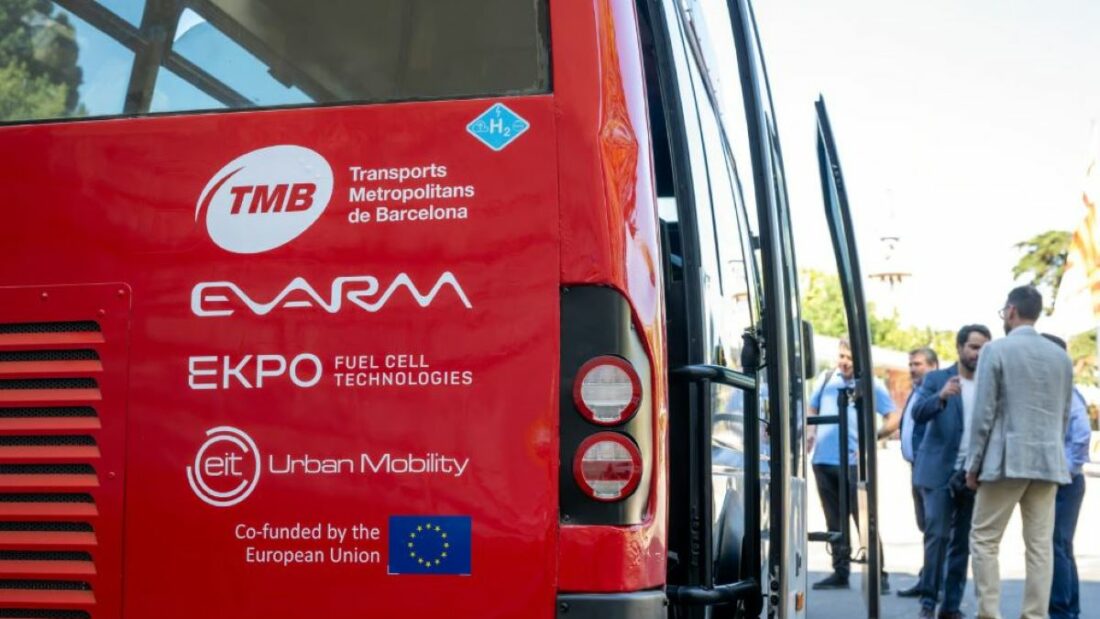A New Chapter in Sustainable Urban Transport in Barcelona
Barcelona is witnessing a breakthrough in eco-friendly public transport with the unveiling of its first hydrogen-powered urban minibus. This innovative vehicle, converted from a traditional diesel minibus, represents a significant stride toward reducing carbon emissions in city transit systems.
The Hydrogen Retrofit Project: How It Works
The transformation was spearheaded by EVARM, a company specializing in converting vehicles to sustainable mobility alternatives. Partnering with Transports Metropolitans de Barcelona (TMB), EIT Urban Mobility, and ACCIO’s Optima office, EVARM took a Mercedes-Benz minibus from TMB’s fleet, commonly known as the ‘Bus del Barri’, and replaced its diesel engine with a cutting-edge electric propulsion system powered by a hydrogen fuel cell.
This fuel cell, developed by EVARM using the compact EKPO stack from Germany, generates up to 120 kW of power. Complemented by a 35 kWh auxiliary battery that the hydrogen system keeps charged throughout the day, the minibus can operate intensively for up to 16 hours between hydrogen refills. This impressive endurance addresses one of the chief concerns in urban logistics: vehicle uptime.
Table: Key Technical Features of the Hydrogen Minibus
| Functie | Beschrijving |
|---|---|
| Original Vehicle | Mercedes-Benz ‘Bus del Barri’ minibus from TMB fleet |
| Engine Conversion | Diesel replaced with hydrogen fuel cell and electric motor |
| Fuel Cell Power | 120 kW EKPO stack (ultracompact design) |
| Auxiliary Battery Capacity | 35 kWh, continuously charged by hydrogen fuel cell |
| Operational Autonomy | Up to 16 hours of intensive use between hydrogen refills |
Pilot Phase and Future Prospects
The minibus entered its pilot phase in March 2025, starting with test runs without passengers to assess its efficiency, range, and maneuverability within the busy urban landscape of Barcelona. Once these validation stages are completed successfully, the vehicle is expected to join official service, paving the way as the city’s first fully operational hydrogen fuel cell minibus.
Driving Decarbonization in Urban Mobility
Reducing carbon emissions in professional transportation is crucial, and urban public transit sits at the crossroads of this effort. The project’s leaders see this vehicle as a flagship example of how technology and cooperation can make large-scale decarbonization a reality. EVARM’s CEO, Xavier Ribas, emphasized that such initiatives are the “first step of an international-scale project,” highlighting the broader ambition underlying this local innovation.
Collaboration at the Heart of Innovation
The success of the hydrogen retrofit project owes much to multi-organization collaboration. Alongside EVARM and TMB, which not only provided the vehicle but also supported the trial runs, EIT Urban Mobility and EKPO—maker of the hydrogen stack—played vital roles. Technical coordination by the Catalan Institute for Energy Research (IREC) further ensured the project adhered to rigorous standards.
Impact on Industrial Freight and Urban Logistics
The adoption of hydrogen fuel cell technology in urban minibuses holds profound implications for logistics and freight movement within cities. The technology promises cleaner last-mile deliveries and smoother integration of bulky or heavy cargo without compromising emission goals. As EVARM advances plans to mass-produce hydrogen electric trucks and buses, the ripple effects on freight transport efficiency and environmental impact stand to be significant.
Why This Matters for Logistics and Transport Services
With the global push toward green logistics, innovations like hydrogen-powered minibuses showcase the potential to reduce urban air pollution and improve quality of life. For logistics providers moving bulky items or managing urban freight, such vehicles offer a dual advantage—zero emissions and operational flexibility with long daily endurance.
Highlights of the Hydrogen Minibus Development
- First retrofit of an existing diesel urban minibus to hydrogen fuel cell power in Barcelona
- Extended 16-hour operational capacity suits intensive urban logistics needs
- Successful collaboration among public transport operators, technology developers, and energy research institutes
- Scaling hydrogen tech to trucks and buses can transform city freight and passenger transport sectors
Of course, while positive reviews and reports paint an encouraging picture, there’s no substitute for experiencing such innovations firsthand. Platforms like GetTransport.com allow users to explore affordable and reliable cargo transportation options worldwide, helping make informed decisions without breaking the bank or facing disappointing service. The convenience, competitive pricing, and wide-ranging choices offered by GetTransport.com align perfectly with the evolving landscape of sustainable transport showcased in projects like EVARM’s hydrogen minibus. Boek je rit op GetTransport.com to tap into these benefits.
Looking Ahead: Sustainability and Logistics
Although this hydrogen minibus retrofit might seem like a piece in the vast puzzle of global logistics, it signals a growing trend toward greener urban transport solutions that will inevitably influence cargo and freight strategies. The shift to zero-emission fleets will reshape distribution, delivery, and relocation services, demanding adaptable, innovative logistics solutions. GetTransport.com keeps its finger on the pulse of such developments, ensuring customers access the best in affordable, global transport options. Start planning your next delivery and secure your cargo with GetTransport.com.
Conclusie
The adaptation of a conventional diesel minibus into a hydrogen fuel cell electric vehicle is a landmark achievement for Barcelona and a beacon for sustainable urban transit worldwide. This initiative exemplifies how effective partnerships and forward-thinking technologies can deliver reliable, low-emission transport solutions for both passenger and freight applications. As hydrogen fuel cell vehicles enter mass production, their role in transforming logistics—through cleaner haulage, distribution, and urban freight movement—will grow increasingly vital. GetTransport.com perfectly complements this evolution by offering users comprehensive, cost-effective, and dependable options for moving everything from bulky cargo to vehicles, making the management of global shipments and relocations simpler than ever.

 EVARM Introduces Barcelona’s First Hydrogen-Powered Urban Minibus through Diesel Vehicle Retrofit">
EVARM Introduces Barcelona’s First Hydrogen-Powered Urban Minibus through Diesel Vehicle Retrofit">